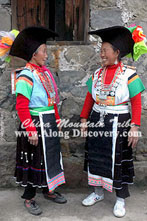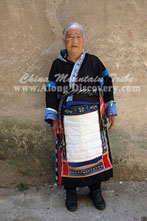 |
SW China/Guizhou Textiles & Festival Travel Guide |
| The
Dong
The Dong is one of
the tribes with a very long history whose people living in Linna(
Fujian and Guangdong of today ) during the Spring and autumn period
was called "Luoyue", "Liao" in the Wei and Jin
dynasties. The Dong was named " Dong" after the Ming dynasty,
a kind of organization called " Kuan" appeared in the
Dong community with the development of economy and the private owning
of land. The leader of it was called " Kuanshou" which
is divided into " Dakuan" and "Xiaokuan", the
"Dakuan" owns a huge of lands spreading more than 50 kms
far and wide. The "Kuanshou" was the leader of military
affairs, he became the ruler relying on his own of the the power
of politics, economics and military. Rice is the Dong's
staple food, sticky rice is their favorite. They particularly enjoy
sour food as well as rice wine. The region inhabited by Dong is
rich in China firs, so they use wood to build their houses, drum
towers and wind and rain bridges. The Dong also like drinking oil
tea which is a specialty of them. The Dong are excellent
architects. When you walk to the Dong villages of the Souther Dong
region, you will see beautiful and exquisite drum towers and wind
and rain bridges every where. Drum towers and wind and rain bridges
become the symbol of a Dong village. In Congjiang, Liping, nearlly
every village has drum towers, of course not every village has drum
towers, but when you see drum towers in a village, it must be a
Dong village. Some villages have a drum tower, some have more drum
towers. For example, there are 5 drum towers in Zhaoxing village,
that means there are 5 clans in the village. The wooden drum tower
is connected by mortises and tenons without any nails. Its bottom
part is square, and the upper part is octagonal or hexagonal, and
the number of the floors on the drum tower is also odd number, namely
from 3, 5,7, 9,11,13 and the like. The highest one exsited nowadays
is the one newly built in Congjiang near the main high way. Some
drum towers have survived for many decades, the drum tower in Zengcong,
Congjiang county is the well preseverd one which has the longest
age, built in 1672, this drum tower is one of the national key protection
relics, The docrations on the drum towers are very beautiful, the
patterns are from village life to ancient legendary stories or mythes,
and they are vivid and true to life. Unfortunately the village is
only accessible by 4 WD jeeps. The wind and rain bridge
is also the Dong another's outstanding architecture, the bridge
becomes a place for the villagers to keep shelter from rain and
sun during the summer season, hence wind and rain bridge. The wind
and rain bridge is also called " flower bridge". The wind
and rain bridges in Guizhou have many beautiful painted pictures,
the motifs are from Dong people's daily life, festivals to chinese
ancient stories. The most elegant and oldest wind and rain bridge
is the one in Diping, Liping, it was built in 1873, the bridge was
burnt several times and rebuilt, unfortunately it was destroyed
again by the big flood of a few year ago. Now a new one with the
same length and size was completed building. The Dong language belongs
to Sino-Tibetan language family, Zhuang Dong branch which is similar
to the Tai language. The Dong have no written language, in 1956,
the Chinese government transcribed the written language for the
Dong by using Lantin words-Chinese pinyin. The Dong are good
at singing, and there are various songs, the most noted is the Dong
big song which has been known both at home and abroad. The popular
musical instruments of the Dong are Lusheng, Pipa and Legged violin.
A little girl must learn singing folk songs from the old since her
childhood. The Southern Dong
women also like embroidery and silver ornaments, the twisted stitch
of the Dong is very superb. The Dong of China is classified into the Northern Dong and the Southern Dong. The northern Dong region includes Tianzhu, Jinping, Jianhe, Zhenyuan, Sansui and Yuping of Guizhou and Tongdao, Jinzhou of Hunan whose traditional costumes and architectures are not really well preserved dut to the more developed transportation and the living close to Han. Women usually seldom wear traditional costume for working in the fields. Only on some festival occastions, for instance, the women in Baojin, Zhenyuan still wear emboidered dress and silver for the festival of " San Yue San". However Sanmentang in Tianzhu is the exception there you can find old stone tablets and family ancestral temples are well preserved from the Ming and Qing dynasties, it worth a visit If you want to make the trip to Sanmentang, you may connect the journey to Longli old town in Jinping, then to Liping. The southern Dong region includes Liping, Congjiang, Rongjiang of Guizhou and Sanjiang, Rongshui and Rong'an of Guangxi. However, the Southern Dong's traditional costume and architectures are so well conserved because they live in the remote region with poor transportation. Even not on festival days, you still can see women in traditional leggings and dress. Especially the drum tower and wind and rain bridge are everywhere in the villages. Furthermore, the market of the southern Dong region is very interesting. If lucky, you will see the market in Xiajiang or Tingdong on the way from Rongjiang to Congjiang, the Miao girls join the market in silver jewelry, the Dong women also dress beautiful costume, so I highly recommend the tour to the southern Dong region. You may make the tour suggested as below:
|
|
 |




